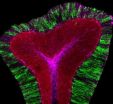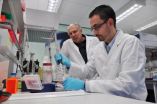(Press-News.org) JUPITER, FL, June 18, 2014 – Scientists from the Florida campus of The Scripps Research Institute (TSRI) have shed light on how a specific kind of genetic mutation can cause damage during early brain development that results in lifelong learning and behavioral disabilities. The work suggests new possibilities for therapeutic intervention.
The study, which focuses on the role of a gene known as Syngap1, was published June 18, 2014, online ahead of print by the journal Neuron. In humans, mutations in Syngap1 are known to cause devastating forms of intellectual disability and epilepsy.
"We found a sensitive cell type that is both necessary and sufficient to account for the bulk of the behavioral problems resulting from this mutation," said TSRI Associate Professor Gavin Rumbaugh, who led the study. "Because we found the root biological cause of this genetic brain disorder, we can now shift our research toward developing tailor-made therapies for people affected by Syngap1 mutations."
In the study, Rumbaugh and his colleagues used a mouse model to show that mutations in Syngap1 damage the development of a kind of neuron known as glutamatergic neurons in the young forebrain, leading to intellectual disability. Higher cognitive processes, such as language, reasoning and memory arise in children as the forebrain develops.
Repairing damaging Syngap1 mutations in these specific neurons during development prevented cognitive abnormalities, while repairing the gene in other kinds of neurons and in other locations had no effect.
Rumbaugh noted prenatal diagnosis of some infant genetic disorders is on the horizon. Technological advances in genetic sequencing allow for individual genomes to be scanned for damaging mutations; it is possible to scan the entire genome of a child still in the womb. "Our research suggests that if Syngap1 function can be fixed very early in development, this should protect the brain from damage and permanently improve cognitive function," said TSRI Research Associate Emin Ozkan, a first author of the study, along with TSRI Research Associate Thomas Creson. "In theory, patients then wouldn't have to be subjected to a lifetime of therapies and worry that the drugs might stop working or have side effects from chronic use."
Mutations to Syngap1 are a leading cause of "sporadic intellectual disability," resulting from new, random mutations arising spontaneously in genes, rather than faulty genes inherited from parents. Intellectual disability affects approximately one to three percent of the population worldwide.
Rumbaugh and his colleagues are continuing to investigate. "Our findings have also identified exciting potential biomarkers in the brain of cognitive failure, allowing us to test new therapeutic strategies in our Syngap1 animal model," said Creson.
INFORMATION:
In addition to Rumbaugh, Ozkan and Creson, other authors of the study "Reduced Cognition in Syngap1 Mutants Is Caused by Isolated Damage within Developing Forebrain Excitatory Neurons" include Courtney Miller and Camilo Rojas of TSRI; Enikö A. Kramár, Ron R. Seese, Alex H. Babyan, Yulin Shi, Xiangmin Xu and Gary Lynch of the University of California, Irvine; and Rocco Lucero and Jeffrey L. Noebels of Baylor College of Medicine.
The study was supported by the National Institute for Neurological Disorders and Stroke (grants R01NS064079, NS29709 and NS045260), National Institute for Mental Health (grant R01MH096847), National Institute for Drug Abuse (grants R01 DA034116 and R03 DA033499), the University of California, Irvine, and the State of Florida.
Scripps Florida scientists pinpoint how genetic mutation causes early brain damage
2014-06-18
ELSE PRESS RELEASES FROM THIS DATE:
Blocking brain's 'internal marijuana' may trigger early Alzheimer's deficits, study shows
2014-06-18
A new study led by investigators at the Stanford University School of Medicine has implicated the blocking of endocannabinoids — signaling substances that are the brain's internal versions of the psychoactive chemicals in marijuana and hashish — in the early pathology of Alzheimer's disease.
A substance called A-beta — strongly suspected to play a key role in Alzheimer's because it's the chief constituent of the hallmark clumps dotting the brains of people with Alzheimer's — may, in the disease's earliest stages, impair learning and memory by blocking the natural, beneficial ...
Groundbreaking model explains how the brain learns to ignore familiar stimuli
2014-06-18
Dublin, June 18th, 2014 – A neuroscientist from Trinity College Dublin has proposed a new, ground-breaking explanation for the fundamental process of 'habituation', which has never been completely understood by neuroscientists.
Typically, our response to a stimulus is reduced over time if we are repeatedly exposed to it. This process of habituation enables organisms to identify and selectively ignore irrelevant, familiar objects and events that they encounter again and again. Habituation therefore allows the brain to selectively engage with new stimuli, or those that ...
Fight-or-flight chemical prepares cells to shift brain from subdued to alert
2014-06-18
A new study from The Johns Hopkins University shows that the brain cells surrounding a mouse's neurons do much more than fill space. According to the researchers, the cells, called astrocytes because of their star-shaped appearance, can monitor and respond to nearby neural activity, but only after being activated by the fight-or-flight chemical norepinephrine. Because astrocytes can alter the activity of neurons, the findings suggest that astrocytes may help control the brain's ability to focus.
The study involved observing the cells in the brains of living, active mice ...
Modeling how neurons work together
2014-06-18
A newly-developed, highly accurate representation of the way in which neurons behave when performing movements such as reaching could not only enhance understanding of the complex dynamics at work in the brain, but aid in the development of robotic limbs which are capable of more complex and natural movements.
Researchers from the University of Cambridge, working in collaboration with the University of Oxford and the Ecole Polytechnique Fédérale de Lausanne (EPFL), have developed a new model of a neural network, offering a novel theory of how neurons work together when ...
Stem pipeline problems to aid STEM diversity
2014-06-18
PROVIDENCE, R.I. [Brown University] — Decades of effort to increase the number of minority students entering the metaphorical science, technology, engineering, and math (STEM) pipeline, haven't changed this fact: Traditionally underrepresented groups remain underrepresented. In a new paper in the journal BioScience, two Brown University biologists analyze the pipeline's flawed flow and propose four research-based ideas to ensure that more students emerge from the far end with Ph.D.s and STEM careers.
Senior author Andrew G. Campbell, associate professor of biology, said ...
Nanoparticles from dietary supplement drinks likely to reach environment, say scientists
2014-06-18
Nanoparticles are becoming ubiquitous in food packaging, personal care products and are even being added to food directly. But the health and environmental effects of these tiny additives have remained largely unknown. A new study now suggests that nanomaterials in food and drinks could interfere with digestive cells and lead to the release of the potentially harmful substances to the environment. The report on dietary supplement drinks containing nanoparticles was published in the journal ACS Sustainable Chemistry & Engineering.
Robert Reed and colleagues note that food ...
BU-lead study shows surprising spread of spring leaf-out times
2014-06-18
(Boston) – Despite conventional wisdom among gardeners, foresters and botanists that woody plants all "leaf out" at about the same time each spring, a new study organized by a Boston University biologist found a surprisingly wide span of as much as three months in leaf-out times. Significantly, observations the past two springs of 1,597 woody plants in eight botanical gardens in the U.S., Canada, Germany and China suggest that species differences in leaf-out times could impact the length of the growing season and the activities of birds, insect and other animals and therefore ...
Innovative technologies in rural areas improve agriculture, health care
2014-06-18
TAMPA, Fla. (June 18, 2014) – The current special issue of Technology and Innovation is devoted to articles on both innovations in rural regions and general articles on technology and innovation, including an article from the National Academy of Inventors (NAI) by McDevitt et al. that discusses the value of technology transfer for universities beyond money.
The five papers in this special issue of Technology and Innovation dealing with innovations in rural regions include an editorial, an analysis of the value of networks for European organic farmers and conventional ...
Self-repairing mechanism can help to preserve brain function in neurodegenerative diseases
2014-06-18
New research, led by scientists at the University of Southampton, has found that neurogenesis, the self-repairing mechanism of the adult brain, can help to preserve brain function in neurodegenerative diseases such as Alzheimer's, Prion or Parkinson's.
The progressive degeneration and death of the brain, occurring in many neurodegenerative diseases, is often seen as an unstoppable and irrevocable process. However, the brain has some self-repairing potential that accounts for the renewal of certain neuronal populations living in the dentate gyrus, a simple cortical region ...
When it comes to numbers, culture counts
2014-06-18
CAMBRIDGE, MA -- American children learn the meanings of number words gradually: First they understand "one," then they add "two, "three," and "four," in sequence. At that point, however, a dramatic shift in understanding takes place, and children grasp the meanings of not only "five" and "six," but all of the number words they know.
Scientists have also seen this pattern in children raised speaking other languages, including Japanese and Russian. In all of these industrialized nations, number learning begins around age 2, and children fully understand numbers and counting ...




